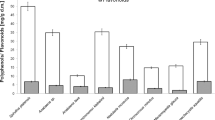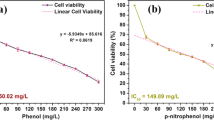Abstract
The cyanobacterium Microcystis produces volatile organic compounds such as β-cyclocitral and 3-methyl-1-butanol. The lysis of cyanobacteria involving the blue color formation has been occasionally observed in a natural environment. In this study, we focused on the oxidation behavior of β-cyclocitral that contributed to the blue color formation in a natural environment and compared β-cyclocitral with a structurally related compound concerning its oxidation, acidification, and lytic behavior. The oxidation products of β-cyclocitral were identified by the addition of β-cyclocitral in water, in which 2,2,6-trimethylcyclohex-1-ene-1-yl formate and 2,2,6-trimethylcyclohexanone were structurally characterized. That is, β-cyclocitral was easily oxidized to produce the corresponding carboxylic acid and the enol ester in water without an oxidizing reagent, suggesting that this oxidation proceeded according to the Baeyer-Villiger oxidation. The oxidation behavior of β-cyclocitral in a laboratory was different from that in the natural environment, in which 2,2,6- trimethylcyclohexanone was detected at the highest amount in the natural environment, whereas the highest amount in the laboratory was β-cyclocitric acid. A comparison of β-cyclocitral with structurally similar aldehydes concerning the lytic behavior of a Microcystis strain and the acidification process indicated that only β-cyclocitral was easily oxidized. Furthermore, it was found that a blue color formation occurred between pH 5.5 and 6.5, suggesting that chlorophyll a and β-carotene are unstable and decomposed, whereas phycocyanin was stable to some extent in this range. The obtained results of the characteristic oxidation behavior of β-cyclocitral would contribute to a better understanding of the cyanobacterial life cycle.





Similar content being viewed by others
References
Arii S, Tsuji K, Tomita K, Hasegawa M, Bober B, Harada K-I (2015) Blue color formation of cyanobacteria during lysis process under natural conditions. Appl Environ Microbiol 81(8):2667–2675
Chorus I, Bartram J (1999) Toxic cyanobacteria in water. E & FN Spon, London
Fallon RD, Brook TD (1979) Lytic organisms and photooxidative effects: influence on blue-green algae cyanobacteria in Lake Mendota. Wisconsin Appl Environ Microbiol 38(3):499–505
Fujise D, Tsuji K, Fukusima N, Kawai K, Harada K-I (2010) Analytical aspects of cyanobacterial volatile organic compounds for investigation of their production behavior. J Chromatogr A 1217(39):6122–6125
Harada K-I, Tsuji K, Ohta A, Takayanagi K, Tamaki S, Suzuki T, Ito E, Fujii K (2007) Isolation of a lytic bacterium against cyanobacteria and its active compounds. J Res Inst Meijo Univ 6:17–28
Harada K-I, Ozaki K, Tsuzuki S, Kato H, Hasegawa M, Kuroda EK, Arii S, Tsuji K (2009) Blue color formation of cyanobacteria with β-cyclocitral. J Chem Ecol 35(11):1295–1301
Hashimoto EH, Kato H, Kawasaki Y, Nozawa Y, Tsuji K, Hirooka EY, Harada K-I (2009) Further investigation of microbial degradation of microcystin using advanced Marfey’s Method. Chem Res Toxicol 22:391–398
Leisch H, Morley K, Lau PCK (2011) Baeyer-Villiger monooxygenase: more than just green chemistry. Chem Rev 111(7):4165–4222
Nozawa Y, Kawashima A, Hashimoto EH, Kato H, Harada K-I (2009) Application of log D for the prediction of hydrophobicity in advanced Marfey’s Method. J Chromatogr A 1216(18):3807–3811
Ozaki K, Ohta A, Iwata C, Horikawa A, Tsuji K, Ito E, Ikai Y, Harada K-I (2008) Lysis of cyanobacteria with volatile organic compounds. Chemosphere 71(8):1531–1538
Sigee DC (2005) Freshwater microbiology: biodiversity and dynamic interactions of microorganisms in aquatic environment. John Wiley and Sons, Inc., Chichester, UK
Sigee DC, Glenn R, Andrews MJM, Bellinger EG, Butler RD, Epton HA, Hendry RD (1999) Biological control of cyanobacteria: principles and possibilities. Hydrobiologia 395–396:161–172
Uchida H, Kouchiwa T, Watanabe K, Kawasaki A, Hodoki Y, Ohtani I, Yamamoto Y, Suzuki M, Harada K-I (1998) A coupled assay system for the lysis of cyanobacteria. J Water Treat Biol 34(1):67–75
Watanabe MF, Harada K-I, Carmichael WW, Fujiki H (1996) Toxic microcystis. CRC Press, Boca Raton, FL
Wu ZX, Gan NQ, Huang Q, Song LR (2006) Response of Microcystis to copper stress: do phenotypes of Microcystis make a difference in stress tolerance? Environ Pollu 147(2):324–330
Acknowledgments
We acknowledge Drs. Atsushi Miyachi and Andrea Roxanne J. Anas and Mr. Kohei Kawai for measurement of the high-resolution mass spectral data, NMR measurement, and technical assistance, respectively, in this study.
Author information
Authors and Affiliations
Corresponding author
Additional information
Responsible editor: Philippe Garrigues
Electronic supplementary material
Below is the link to the electronic supplementary material.
ESM 1
(PDF 617 kb)
Rights and permissions
About this article
Cite this article
Tomita, K., Hasegawa, M., Arii, S. et al. Characteristic oxidation behavior of β-cyclocitral from the cyanobacterium Microcystis . Environ Sci Pollut Res 23, 11998–12006 (2016). https://doi.org/10.1007/s11356-016-6369-y
Received:
Accepted:
Published:
Issue Date:
DOI: https://doi.org/10.1007/s11356-016-6369-y




